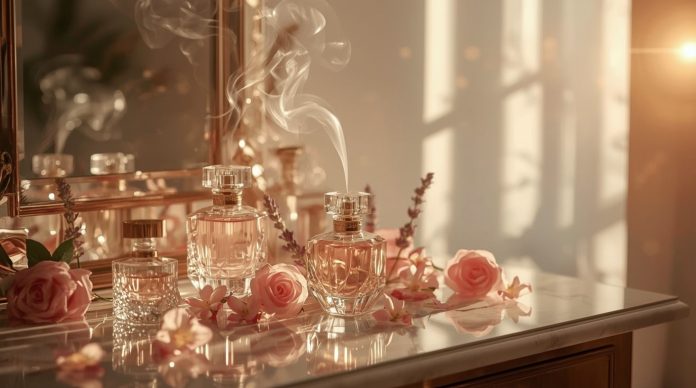Perfume
Perfume is more than a pleasant scent – it is a blend of art, chemistry, and personal expression. Perfume comes from the Latin per fumus meaning “through smoke”, reflecting ancient practices of perfuming with incense. In modern terms, perfume refers to a scented mixture of essential oils, aroma compounds, fixatives, and solvents, designed to give an agreeable fragrance to the body or environment. As one author notes, “Fragrance, like fashion, envelops the body and exposes the soul; … a scented wake magnifies a person’s allure.” This highlights perfume’s role in self-expression and style. Today, perfume is a significant cultural and commercial force worldwide, used in religious rituals, social customs, and as an everyday personal accessory.
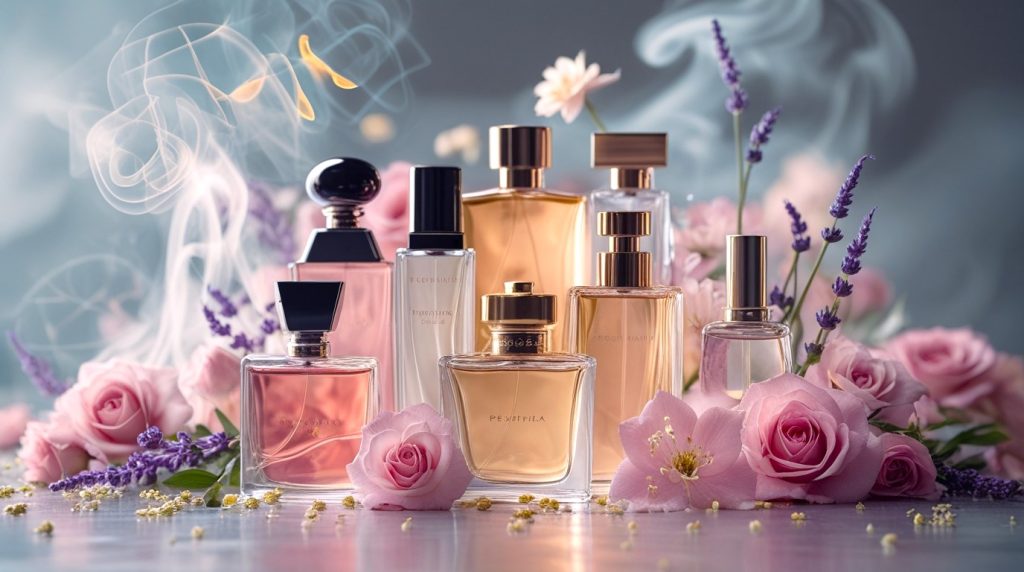
The Rich History of Perfume
Ancient Origins
Perfume’s story goes back thousands of years. The world’s first recorded chemist was Tapputi, a palace perfumer in 1200 BCE Mesopotamia. She recorded techniques for extracting scents, laying a foundation for perfumery. Ancient Egyptians used fragrant oils in religious ceremonies, burial rites and daily life, blending aromatic herbs and resins in ritual fires. Archaeologists have even uncovered a 4,000-year-old perfumery on Cyprus – a Bronze Age factory with dozens of stills. These finds show that perfume-making was an established craft by ancient times.
Cultural Evolution Through Civilizations
As civilizations spread, so did the art of perfume. The Greeks and Romans refined perfumery and connected scents to gods and beauty rituals. Classical writers like Theophrastus and Pliny described perfume ingredients and methods. In the Islamic Golden Age, Persian and Arab scholars perfected distillation and introduced new materials. For example, Avicenna (Ibn Sina) in the 10th century developed steam distillation of rose oil, yielding a delicate rose water rather than just oil blends. His work influenced European science and fragrance making.
By the Renaissance, perfumery returned to prominence in Europe. Catherine de’ Medici brought Italian scents to 16th-century France, effectively launching France’s perfume industry. Later, Grasse in Provence became a perfume capital, using local flowers (lavender, jasmine, rose). In the late 19th century, chemistry revolutionized perfumery: the first synthetic aromatic compounds (e.g. coumarin) were created, allowing fragrances like Guerlain’s Jicky (1889) that no natural extract could match. This modern era of synthesis made perfumes more varied, consistent, and affordable.
The Science of Perfume Creation
Perfume Composition and Structure
Perfume is a carefully formulated blend of aromatic ingredients. It follows an olfactory pyramid of notes:
- Top notes – the first impression (citrus, herbs);
- Middle (heart) notes – the core character (floral, fruity);
- Base notes – long-lasting foundation (woods, musks).
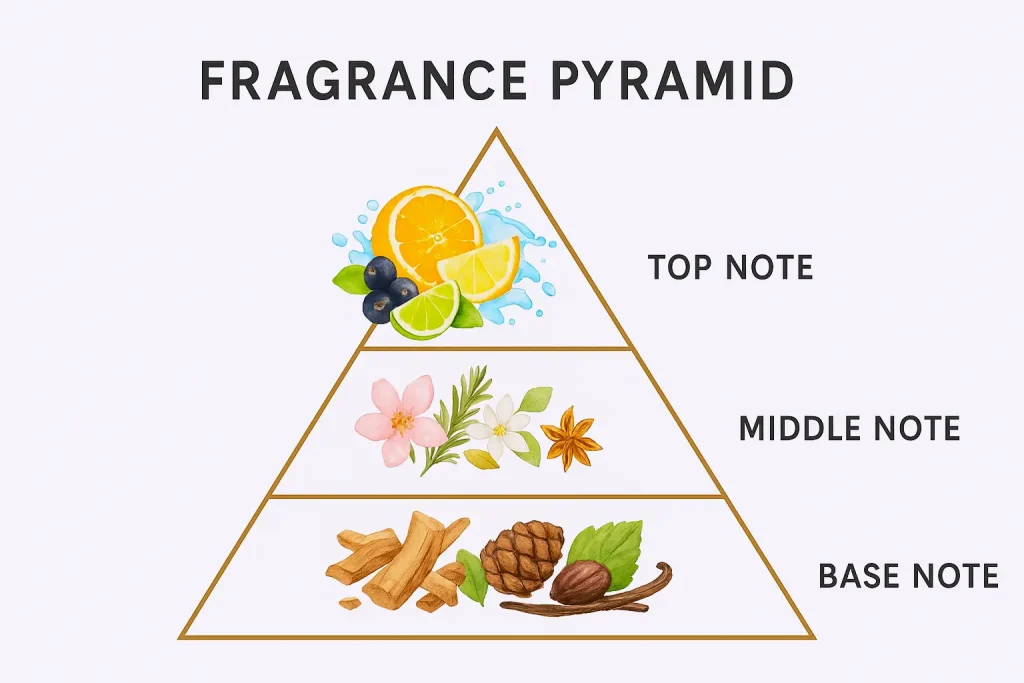
Each fragrance can include dozens of raw materials. In fact, more than 3,000 natural or synthetic substances are used in perfumery. The basic recipe is “a mixture of fragrant essential oils or aroma compounds (fragrances), fixatives and solvents” in liquid form. Fixatives (like benzoin or synthetic musks) slow evaporation to make the scent last. Perfumers think in terms of primary notes (the main accords), modifiers (supporting notes), and blenders/fixatives that hold everything together. All these combine to create the final scent profile.
Perfume Manufacturing Process
1. Sourcing raw materials. High-quality flowers, woods, spices, and other ingredients are gathered worldwide (e.g., Tunisian jasmine, Indian sandalwood). Ethical harvesting and organic cultivation are increasingly important for sustainability.
2. Extraction methods. Aromatic oils and absolutes are extracted from raw materials by several methods:
- Steam distillation: Heating plant material in a still to capture volatile oils (used for rose, lavender, eucalyptus, etc.). This was developed by Arab alchemists and produces both essential oil and hydrosol.
- Solvent (solvent extraction): Using organic solvents (hexane) to extract delicate flower concretes, later made into absolutes.
- Expression (cold pressing): Physically pressing citrus peels to release their oils.
- Enfleurage (historical): Fat absorbs flower scents on glass frames, later washed out with alcohol. (Mostly replaced by solvents in modern industry.)
- Supercritical CO₂ extraction: A newer method using pressurized carbon dioxide to gently extract most compounds (used for amber, resins, rare flowers).
3. Blending by the “nose.” A master perfumer (nose) carefully combines extracts according to their qualities and the desired formula. This artful blending can take years of study.
4. Aging and maturation. Just like fine wine, perfume mixtures often rest for weeks or months. During aging, the components meld and mellow, improving harmony.
5. Filtration and quality control. The aged perfume is filtered to remove impurities and tested to ensure consistency, color, and scent match the formula.
6. Bottling and packaging. Finally, the fragrance is diluted to the correct concentration (see next section), bottled, and attractively packaged for sale. Quality packaging (dark glass, sturdy boxes) also helps preserve the scent.
Natural vs. Synthetic Ingredients
Perfumes use both natural extracts (from flowers, woods, spices, resins, etc.) and synthetic molecules (chemically created scents). Each has benefits and drawbacks. Natural ingredients (e.g. rose, jasmine, sandalwood) are prized for their authenticity and eco-friendly image, but can be very costly, seasonal, or at risk of overharvesting. For example, oud wood commands up to $5,000 per pound raw. Natural materials are biodegradable, but high demand has led to sustainability concerns (e.g. wild jasmine or rose fields).
Synthetic ingredients (e.g. musks, vanillin) offer consistency, greater variety, and year-round availability. They often originate from petrochemicals, which can have an environmental footprint, but they also avoid some ecological issues (no need to farm rare plants). Modern perfumers use synthetics to replicate or extend natural aromas, and many high-quality perfumes blend both. Ethically, synthetics eliminate the need for animal-derived musks or ambergris (both controversial), and can be produced without animal testing under strict regulations. In practice, regulations like IFRA ensure safety by limiting each ingredient’s use.
Fragrance Families and Classifications
The Seven Main Fragrance Families
To organize the vast world of scents, perfumes are grouped into families (also called “olfactive families”) based on their dominant character. The classic seven families are:
- Floral: Dominated by one or more flowers (rose, jasmine, lily, etc.). This is the largest category, ranging from light bouquets to heavy, heady blossoms.
- Woody: Warm, earthy scents with cedar, sandalwood, vetiver, or oud. Often used for sophisticated, grounding fragrances.
- Oriental (Amber): Rich, exotic, and sensual. Typical notes include vanilla, amber, resins (benzoin, labdanum), and spices. The term amber refers to the golden warmth of these blends.
- Fresh: Clean and invigorating. Encompasses citrus scents (lemon, bergamot, orange) and green or aquatic notes (grass, marine accord). Citrus family in particular is very energizing.
- Citrus: (Often included under Fresh.) Bright, zesty, and summery, built around lemon, lime, grapefruit, or other citrus fruit oils.
- Chypre: A sophisticated hybrid (from French “Cyprus”). Top notes of bergamot or citrus with a mossy, woody base (oakmoss, patchouli). Chypres are complex and have a “forest floor” quality.
- Fougère: (French for “fern-like.”) Combines lavender, oakmoss, and coumarin to create an aromatic, herbaceous accord. It originated in men’s fragrances like Fougère Royale (1882) and smells like a mossy fern/glade.
Detailed Fragrance Profiles
Each family can be broken into subfamilies (fruity, green, spicy, etc.) with common note examples. For instance, floral-oriental (floriental) blends floral and spicy notes, while fresh-aquatic emphasizes sea or ozone accords. Climate and occasion often influence choice: light citrus or aquatic scents are popular in hot summer months, while amber, wood, or gourmand (vanilla/chocolate) scents are favored in cool weather. Gender lines have blurred: many fresh or woody fragrances are marketed as men’s, and florals or gourmands to women, but true unisex fragrances (e.g. crisp citrus or neutral musks) are growing in popularity. Classic examples: florals like rose or jasmine; woody like cedar or smoky oud; oriental like vanilla-cinnamon; citrus like fresh lemon; chypre like bergamot + oakmoss; fougère like lavender and coumarin. Each family’s typical notes and mood help you find scents that suit your style and season.
Perfume Concentrations and Types
Understanding Perfume Strength
Perfumes come in different strengths (concentrations of fragrance oil in alcohol), which affects their intensity and price. The main categories are:
- Parfum (Extrait de Parfum): 20 – 40% aromatic compounds. The richest, most long-lasting form (often 8 + hours).
- Eau de Parfum (EDP): 15 – 20% fragrance. A potent yet wearable strength (typical lasting 5-8 hours).
- Eau de Toilette (EDT): 5 -15% fragrance. Lighter and generally 3-5 hours lasting.
- Eau de Cologne (EDC): 2 – 5% fragrance. Very fresh and dilute (1-3 hours).
- Eau Fraîche: 1 – 3% fragrance. Essentially a body splash.
Higher concentration means more scent per spray, longer longevity, and usually a higher price per milliliter. For example, a Parfum can last 12+ hours on skin, whereas an EDT may only last 4 – 7 hours. Oil-based parfum cores (as used by some niche brands) can push longevity even further (12 – 16 hours). When choosing, consider the occasion: a stronger EDP or Parfum for evening or formal wear, and a lighter EDT or body mist for daytime or hot weather.
Longevity and Performance
A perfume’s staying power depends on its concentration and ingredients. In general, the richer the concentration, the longer it lasts. Ingredients also matter: heavy base notes (musk, oud, patchouli) linger longer than fresh citruses or light florals. As one source notes, “Higher concentrations like Parfum/Extrait (20 – 40% oils) can last over 12 hours, while lighter Eau de Toilette (5 – 15%) might last 4 – 7 hours”. The type of alcohol, formulation, and even skin chemistry (see below) will affect how a perfume unfolds. In terms of value, pricier bottles often simply reflect higher concentration (more precious oils). When shopping, you’ll often pay more for the same scent in Parfum than in EDT.
Famous Perfume Brands and Icons
Luxury Designer Brands
Many famous fashion houses have iconic perfumes. Chanel launched its first fragrance, Chanel No. 5, in 1921 – a groundbreaking aldehydic floral created by chemist Ernest Beaux. No.5 remains a best-seller and a symbol of timeless elegance. Dior followed with classics like Miss Dior (1947) and J’adore. Guerlain, founded in 1828, is one of the oldest houses, known for Shalimar (1925) and Mitsouko. Tom Ford (now part of Estée Lauder) brought celebrity glamour to niche scents with its Private Blend collection (e.g. Oud Wood). Hermès – famous for luxury goods – applies artisan craftsmanship to perfumes like Terre d’Hermès. These luxury brands emphasize high-quality ingredients, elegant packaging, and brand heritage. For example, Chanel No. 5 (1921) was the first couture-branded perfume, setting a standard for designer fragrances. Many designer fragrances cater to trends – for instance, Dior’s Sauvage (2015) capitalizes on the current preference for fresh, spicy men’s scents.
Niche and Artisanal Brands
Beyond the big designers are niche houses prized by enthusiasts. Creed (est. 1760 by family tradition) boasts royal patronage (their Royal Water was made for King George III). Amouage (est. 1983, Oman) specializes in rich Middle Eastern-inspired perfumes, often featuring oud and exotic resins. Jo Malone (London-based) is known for minimalist style and scent layering. Byredo (Stockholm) offers modern, unisex fragrances with clean lines (e.g. Gypsy Water). Other names like Le Labo, Maison Francis Kurkdjian, and Diptyque have cult followings. These artisanal brands often experiment with unusual notes or sustainable practices. Although niche perfumes may cost more, fans feel they offer originality and premium craftsmanship beyond mainstream releases.
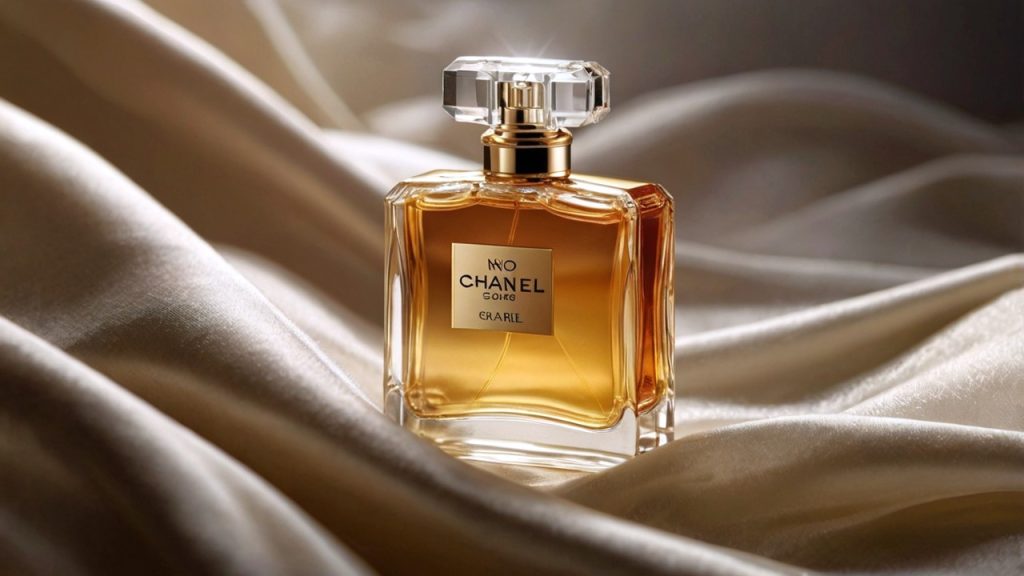
Perfume Culture Around the World
Regional Preferences and Traditions
Perfume tastes vary globally. In the Middle East, rich, complex scents predominate. Ingredients like oud (agarwood) and amber are beloved: in fact, oud is “one of the rarest and most expensive fragrance ingredients” and yields a long-lasting, resinous base note. As an incense (bakhour), oud has played an important role in religious and social rituals in Islamic cultures. Visitors to Dubai or Riyadh can experience bespoke oud oils by the gram.
In Asia, traditions range from Japanese incense ceremonies (Kōdō) to Indian Ayurvedic attars (flower/wood hydrosols). For example, sandalwood and rose attars are common in India’s weddings and festivals. In Europe, especially France and Italy, perfume is tied to couture and luxury; the French city of Grasse remains famous for flower fields and artisan distilleries.
In the Americas, preferences are diverse. American perfumers follow global trends but also favor clean, fresh scents and celebrity endorsements. Cities like New York and Los Angeles have many boutiques and fragrance bars. Notably, North America now accounts for about 35% of the global perfume market, with the U.S. projected to reach $23.2 billion by 2032. Regional climate also influences choices: in hot, humid parts of the U.S. (Florida, Texas), light citrus or aquatic scents are popular in summer, while warm gourmands or woods are chosen for winter.
Cultural Significance
Around the world, perfume carries social and cultural meaning. In Middle Eastern hospitality, guests may be greeted with incense or scented water; in many Muslim communities, wearing fragrance for communal prayers is encouraged as a sign of cleanliness. European traditions include perfumed handkerchiefs or scented bridal bouquets. On a personal level, people use fragrance to express identity: a smoky leather scent can feel adventurous, a soft rose or vanilla can feel comforting. Perfume can mark occasions (e.g. a special anniversary scent) or even create memories (a vacation smell). Across cultures, perfume often evokes status, romance, or spirituality.
Religious and Ritual Use: Many religions use fragrance in worship – e.g., frankincense and myrrh in Christianity, temple incense in Buddhism and Hinduism, and bakhoor (oud resin) in Islamic ceremonies. These practices highlight perfume’s link to the sacred and the communal.
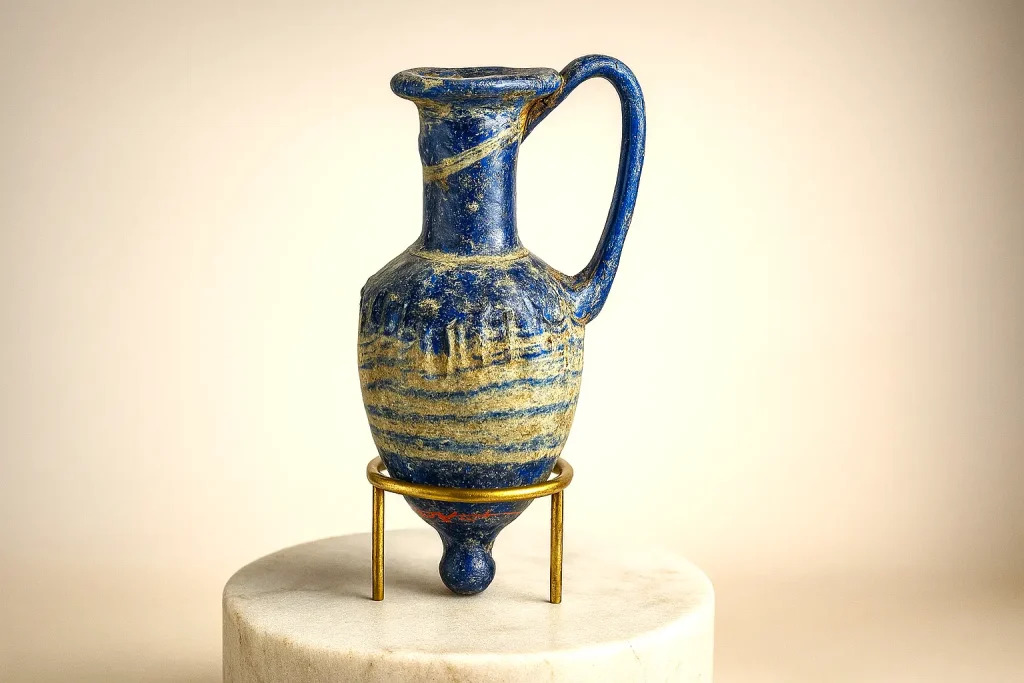
How to Choose the Perfect Perfume
Personal Considerations
Choosing a fragrance starts with self-awareness. Consider the notes you love (fresh citrus? sweet vanilla? green herbs?). Remember that a perfume smells differently on each person due to skin chemistry. Oily, well-moisturized skin holds scents longer, while dry skin may cause a fragrance to fade quickly. For best longevity, apply on slightly damp skin or layer a neutral, unscented lotion underneath.
Also think about when and where you’ll wear it. Light, crisp scents are ideal for daytime or summer. Rich, spicy, or gourmand perfumes suit evening wear or colder weather. It’s helpful to build a small “wardrobe” of scents – for example, a floral perfume for special events and a fresh citrus or fougère for everyday use. Remember that formulas can smell different over time: test the fragrance on your skin and give it an hour to evolve before deciding.
Gender labels are less important than personal preference. Many people search for the “best perfume for women” or “best perfume for men,” but ultimately choose fragrances that resonate with them. A popular women’s perfume might smell lovely on a man’s skin and vice versa. The key is what you like and feel confident wearing.
Testing and Buying Guide
When sampling perfumes:
- Spray on your skin, not just sniffing a blotter. Pulse points like the wrists, inner elbows, or behind the ears emit more heat to diffuse the scent.
- Give it time to develop. After a few sprays, step away and smell it on your skin over 10–30 minutes. Avoid testing multiple scents at once to prevent your nose from getting confused.
- Test in a good environment. Visit a fragrance shop in the late morning (your nose is fresh) and on clean, unscented skin. Avoid strong fragrances in the air that day (coffee, perfume on others) which can interfere.
- Limit choices. Most stores advise trying no more than 3–4 perfumes per visit. If in doubt, take home samples or paper strips. Many brands now sell small samples or discovery sets.
Shopping tips: In the U.S., department stores and beauty shops often offer free samples with purchase. Online fragrance retailers also provide sample vials. Since perfume preference is highly personal, don’t buy the largest bottle on a whim – start small. Finally, consider budget: an Extrait or luxury bottle will cost more than an EDT spray. However, a little higher concentration can sometimes mean using less product per wear, giving better value over time.
Application and Usage Tips
Proper Application Techniques
To wear perfume optimally:
- Moisturize first. Fragrance lasts longer on hydrated skin. Apply an unscented lotion before spritzing perfume.
- Use pulse points. Apply perfume to warm areas like wrists, neck, the inside of elbows, and behind knees. The body’s heat will gently diffuse the scent. Avoid rubbing your wrists together after spraying – this can “break” the molecules and shorten the fragrance life.
- Spray from a distance. Hold the bottle about 4–6 inches from skin and spritz 1–2 times. You want a light mist, not drenching. For hair, a quick spritz in hair (or on a hairbrush) can carry fragrance all day; just be cautious with alcohol on hair (it can dry strands).
- Don’t overspray. It’s better to be subtle. A few sprays are usually enough. Over-applying can overwhelm others and waste perfume.
Making Perfume Last Longer
- Layer wisely. Pair your perfume with matching scented body lotions or shower gels (if available) from the same fragrance line. Alternatively, a fragrance-free petroleum jelly dabbed on pulse points can hold scent.
- Apply after bathing. Perfume adheres better to warm, slightly damp skin immediately after a shower.
- Avoid friction. Rubbing perfume into skin breaks the scent; let it air-dry.
- Carry a travel atomizer. For long days, a small refillable spray helps you refresh midday (especially in warm weather when scents fade faster).
- Rotate wisely. Don’t wear the same perfume every day. Giving fragrances a day or two off between wears lets them “recover” and smell fresher.
- Mist on clothes or scarves. Fabric holds scent longer than skin in many cases (but beware staining; test on inconspicuous fabric first). A light spray on a cotton scarf or jacket collar can enhance longevity.
- Mind the season. In winter, fragrances react differently – you may perceive them as weaker, so a bit extra can be ok. In summer, wear less to avoid being overpowering in the heat.
Perfume Safety and Allergies
Understanding Perfume Allergies
Some people have sensitivity to certain fragrance chemicals. Common allergens in perfumery include terpenes like limonene (citrus scent) and linalool (floral), as well as fragrances like cinnamal, eugenol, and isoeugenol. These can oxidize on air and become irritants. Symptoms of fragrance sensitivity range from skin redness and hives to headaches or respiratory irritation. Organizations like the International Fragrance Association (IFRA) evaluate ingredients and set safe maximum concentrations to minimize allergic reactions. However, anyone prone to allergies should be cautious. A good practice is a patch test: spray a bit of perfume on the inside of your elbow and wait 24 hours to see if irritation occurs. If you notice irritation or a rash, it’s best to avoid that scent or ingredient.
Choosing Safe Fragrances
- Hypoallergenic and natural lines. Some brands offer “allergy-tested” or fragrance-free products. While no perfume is truly allergen-free (as any scent involves chemicals), these lines avoid the most common sensitizers.
- Check labels. In the U.S. and Europe, ingredients like limonene or linalool are often listed if above a certain percentage. If you know you react to a note (e.g. sandalwood), look for labels that exclude it.
- Natural vs. synthetic. Don’t assume “natural” always means safe – natural oils like cinnamon or clove can irritate. Similarly, high-quality synthetics can be designed to be hypoallergenic. It’s about specific compounds, not just “natural.”
- Fragrance-free alternatives. If allergies are severe, use unscented lotions or deodorants and avoid fine fragrances altogether. There are also odor-neutralizing alternatives (like alum crystal sticks or odor-blocking sprays) for those who can’t tolerate perfumes.
- Dilution and air it out. Using a milder concentration (EDT instead of Parfum) or giving a room a quick airing after applying can sometimes reduce strong exposure.
Proper Perfume Storage
Ideal Storage Conditions
Perfume is a delicate formula that can degrade if stored poorly. For longest shelf life, keep bottles in a cool, dark place (ideally 16-22°C / 60-72°F). Avoid sunlight, heat sources, and extreme cold. Light and UV rays can break down fragrance molecules and fade color. Humidity fluctuations (like in bathrooms) can also degrade the scent and cap mechanisms. It’s best to store perfumes in their original boxes or a drawer. For example, luxury houses often ship small samples in tinted vials to protect from light, and bottle sizes larger than 100 mL can degrade faster once opened. In general, unopened perfumes last many years, but once opened, aim to use them within 3 – 5 years for best quality.
Preservation Tips
- Keep them sealed. Always replace the cap tightly after use. This prevents alcohol evaporation and oxidation of the oils. Some people even wrap the box edges with tape for very long storage.
- Avoid shaking. Gentle swirls are fine, but vigorous shaking can incorporate air bubbles, which oxidize the fragrance.
- Watch the clock. Over time, perfume may turn slightly amber or smell “off.” This can be a sign of aging. A rancid or vinegary scent indicates it should be discarded. As a rule, most fine fragrances stay good for at least 2-3 years after opening; beyond that, the notes can change character.
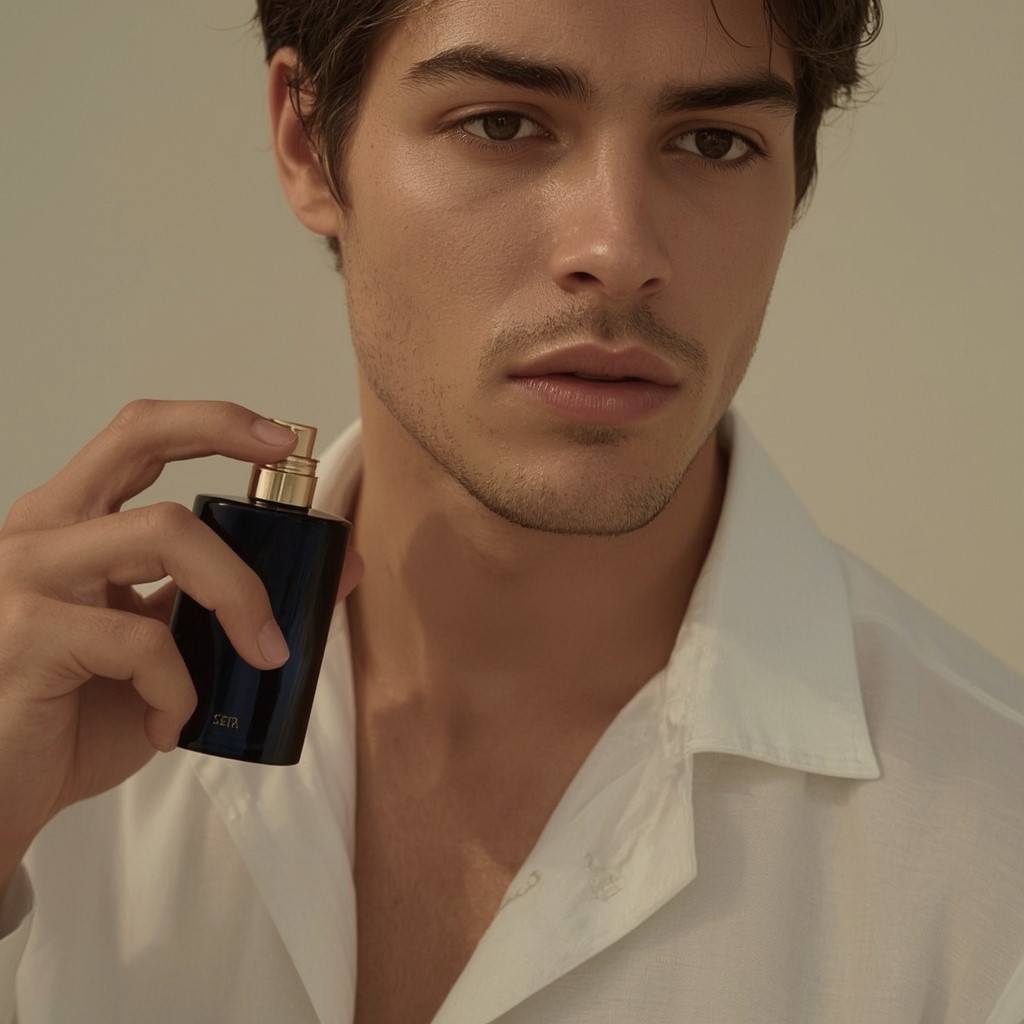
Current Trends and Future of Perfume
2024–2025 Industry Trends
The fragrance world is evolving with the times. Sustainable and clean beauty is a major trend: consumers now expect refillable bottles, recyclable packaging, and ethically sourced ingredients. Niche and mainstream brands alike are launching “green” lines emphasizing natural extracts and transparency (for example, Le Labo and Maison Louis Marie offer refill programs).
Gender-neutral fragrances are on the rise. Many new launches omit gender labels and feature universally appealing notes like woods, spices, and citrus. The packaging often mirrors this with minimalist, monochrome designs.
AI and personalization are emerging: some companies now use artificial intelligence to recommend or even create bespoke scents. For instance, Sephora’s Maison 21G outlet (with an AI-powered app in Asia) offers personalized fragrance profiling. Likewise, algorithmic tools and online quizzes are helping customers find perfect matches to their preferences.
Gourmand and nostalgic scents are also trendy. Vanilla, chocolate, and spiced foods in a bottle are popular, especially for the holiday season. Aldehyde-rich “vintage” perfumes (think Chanel No.5’s soapy sparkle) have made a comeback in modern reinterpretations.
Market Outlook
The global perfume market continues to grow steadily. A recent report valued it at about $50.5 billion in 2024, with projections to reach roughly $77.5 billion by 2032 (about a 5–6% annual growth rate). North America is the largest regional market (over 35% share in 2024), driven by strong sales of premium fragrances. In the U.S., growing disposable income and beauty awareness are fueling demand. Notably, the premium segment (higher price, higher concentration) is expanding fastest as consumers seek unique experiences.
E-commerce and digital transformation are key drivers. More customers now buy perfume online via Amazon, Sephora, brand sites, and specialty retailers. Online sales allow for broader selection (including indie brands) and often attract shoppers with promotions. A Fortune Business Insights analysis notes that rising online shopping (supported by platforms like Amazon and Flipkart) is significantly boosting perfume sales. Brands are responding with digital marketing and virtual try-on tools.
In short, perfume’s future lies in innovation: from eco-friendly formulas and AI customization to creative niche offerings and global expansion. The industry is poised for continued growth, blending tradition with technology to meet diverse consumer tastes.
Conclusion
Perfume is a fascinating fusion of history, art, and science. From ancient rituals to high-tech personalization, it plays a unique role in culture and personal style. We’ve seen how perfumes are made, classified, and chosen, and how brands and trends shape what we wear. Ultimately, finding your perfect scent is a personal journey: experiment with notes, test on your skin, and build a fragrance wardrobe for different moods and seasons. With this guide, you now have the knowledge to explore perfumes deeply – whether browsing a local boutique in New York or discovering an oud oil in Dubai. The world of fragrance is rich and ever-changing; feel free to explore, experiment, and let your signature scent tell your story.
Sources: Authoritative references (open websites and articles) have been cited throughout this article to ensure accuracy. Further reading on perfume history and science can be found on the Wikipedia Perfume page and fragrance industry publications.
